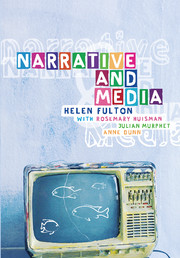Book contents
- Frontmatter
- Contents
- Figures and tables
- Contributors
- Acknowledgements
- 1 Introduction: the power of narrative
- Part 1 The basics of narrative theory
- Part 2 Film as narrative and visual mode
- Part 3 Television: narratives and ideology
- Part 4 Radio and print journalism
- Part 5 Popular print culture
- 18 Magazine genres
- 19 Advertising narratives
- 20 Conclusion: postmodern narrative and media
- Glossary
- Bibliography
- Index
19 - Advertising narratives
Published online by Cambridge University Press: 05 June 2012
- Frontmatter
- Contents
- Figures and tables
- Contributors
- Acknowledgements
- 1 Introduction: the power of narrative
- Part 1 The basics of narrative theory
- Part 2 Film as narrative and visual mode
- Part 3 Television: narratives and ideology
- Part 4 Radio and print journalism
- Part 5 Popular print culture
- 18 Magazine genres
- 19 Advertising narratives
- 20 Conclusion: postmodern narrative and media
- Glossary
- Bibliography
- Index
Summary
In chapter 3 of this book it was pointed out that structuralist studies of narration typically study the text as object, looking for structures and relations within the text. In contrast, post-structuralist studies of narration typically focus on the text in relation to the subject, the subjectivity of the one who is interpreting or producing the text. Thus post-structuralist studies are usually concerned with ideology, with the assumptions of what is ‘natural’ and ‘normal’ to the subject in producing meaning. Post-structuralist studies of narration, then, focus on the ideological orientation of narrative. What stories are told? What stories are repressed? In whose interests is it to tell particular stories, or to repress them? And so on.
In this chapter I bring a post-structuralist perspective to bear on narration in print-culture advertising. Again, I illustrate my general remarks with examples from the October 2001 issue of Australian Women's Weekly.
Magic and information
The collection Media Studies: A Reader, edited by Paul Marris and Sue Thornham, includes seven extracts in the section ‘Advertising’. The first extract is by Raymond Williams, ‘Advertising: The magic system’, written in 1960 but published in 1980 in his book, Problems in Materialism and Culture (Marris & Thornham 1996: 461–5). This is a much-quoted article. For example, it is one of only two articles included under the heading ‘Consumption and the market’ in The Cultural Studies Reader, edited by Simon During (1993: 320–36). I will first describe Williams' account in some detail, then suggest some modifications.
- Type
- Chapter
- Information
- Narrative and Media , pp. 285 - 299Publisher: Cambridge University PressPrint publication year: 2005



